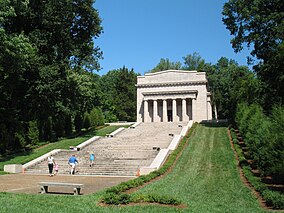Abraham Lincoln Birthplace National Historic Site
| Abraham Lincoln Birthplace National Historical Park | |
|---|---|

Memorial Building
|
|
| Location | LaRue County, Kentucky, USA |
| Coordinates | 37°31′53″N 85°44′10″W / 37.53139°N 85.73611°WCoordinates: 37°31′53″N 85°44′10″W / 37.53139°N 85.73611°W |
| Area | 344.50 acres (139.41 ha) |
| Established | July 17, 1916 |
| Visitors | 169,515 (in 2012) |
| Governing body | National Park Service |
| Website | Abraham Lincoln Birthplace National Historical Park |
Abraham Lincoln Birthplace National Historical Park preserves two separate farm sites in LaRue County, Kentucky where Abraham Lincoln was born and lived early in his childhood. He was born at the Sinking Spring site south of Hodgenville and remained there until the family moved to the Knob Creek Farm northeast of Hodgenville when he was two years old, living there until he was seven years old. The Sinking Spring site is the location of the park visitors center.
In the fall of 1808, Thomas and Nancy Lincoln settled on Sinking Spring Farm. Two months later on February 12, 1809, Abraham Lincoln was born there in a one-room log cabin. Today this site bears the address of 2995 Lincoln Farm Road, Hodgenville, Kentucky. A cabin, symbolic of the one in which Lincoln was born, is preserved within a 1911 memorial building at the site.
Also on the property is the privately owned Nancy Lincoln Inn.
A Beaux-Arts neo-classical Memorial Building was designed by John Russell Pope for the birthplace site. In 1909 the cornerstone was laid by President Theodore Roosevelt and the building was dedicated in 1911 by President William Howard Taft. Almost a hundred years after Thomas Lincoln moved from Sinking Spring Farm, a similar log cabin was placed inside the Memorial Building. The Memorial Building features 16 windows, 16 rosettes on the ceiling, and 16 fence poles, representing Lincoln being the 16th president. The 56 steps leading up to the building entrance represent his age at his death.
The original log cabin that Lincoln was reputed to have been born in was dismantled sometime before 1865. Local tradition held that some of the logs from the cabin were used in construction of a nearby house. New York businessman A.W. Dennett purchased the Lincoln farm in 1894 and used the logs from this house to construct a cabin similar in appearance to the original cabin where Lincoln was born. Soon the cabin was dismantled and re-erected for exhibition in many cities. Eventually the logs for this cabin, along with logs incorrectly reputed to have belonged to Jefferson Davis' birthplace and possibly a third cabin, were purchased by the Lincoln Farm Association (LFA), which believed they had acquired only Lincoln logs. When workers tried to reconstruct the cabin, they discovered the problem. The LFA bought a one-room cabin similar to the one reconstructed by Dennett. When the last rebuilt cabin was placed in the Memorial Building, its size made visitor circulation difficult. The LFA reduced the cabin's size from 16-by-18 feet to 12-by-17 feet.
...
Wikipedia

